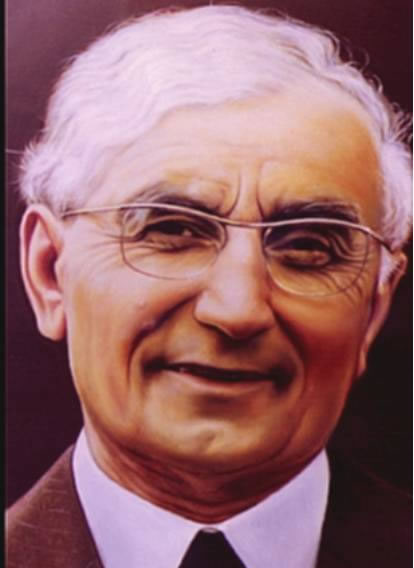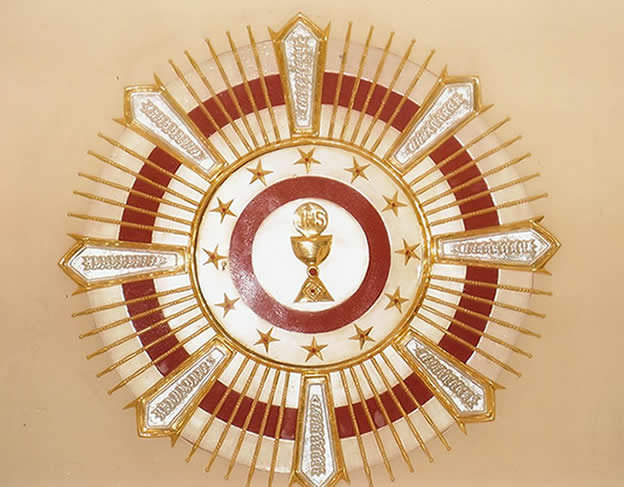The Founder: Priesthood & Apostolate
Priesthood
Bernhard Bendel was ordained a priest by his Bishop Antonius Hilfrich on December 8th, 1933, the feast of the Immaculate Conception. It was on a Friday when he received the Sacrament on Holy Orders through the “laying on of hands” by his Bishop and all priests present. He had finally reached the goal that he had taken upon himself with much labor and personal sacrifice. That day marked the end of Bernhard’s youth.
Two days later, he celebrated his First Solemn Mass of Thanksgiving in his village Parish Church. The whole family united with all villagers to celebrate this great event. All the parishioners focused their attention on Father Bernhard. Because of his simplicity he could not feel too comfortable being the center of attention on that day.
Father Bernhard’s life was dedicated to his duties. Soon after his ordination, he knew the time had come to produce what he had invested for many years. His work was to become the image and likeness of Christ, the perfect man. One could call him a living exegesis, as he lived his life in the work of Spirit, for the Spirit summons the hearts of the people to the fringes of the Church and beyond. He was sensitive to the signs of the times: Hitler’s challenges and heretic ideologies against the Church.
He worked hard to face those challenges by defending the Catholic Church in its faith, doctrine and teachings and to encourage people to be faithful to Christ and to the Church. Father Bernhard as a young priest was influenced by this challenging time of Hitler’s regime. He influenced the people he met to profess their Christianity. He worked and learned to look with new eye at reality, to become aware of the urgency and necessities of the both the Church and the World. To live in his daily life so that others could be drawn and called to share or hear the true Gospel message, in order to build up the body of the Church.
1. From March 1934-1940; He worked in several parishes in German as an assistant parish priest (or a chaplain or a curate). The places he worked as assistant parish priests are; Bad Schwalbach (March 1934 – March 1936), Geisenheim (April 1936 – June 1937), Neuenhain (July 1937 – February 1940), and Hattershein with the Filial Parish Okriftel (March 1940 - May 1940)
2. From June 1940- 1957; He was assigned an assistant parish priest in Mammolshain. In fact, after this appointment, he remained in Mammolshain for the rest of his priestly life. He was still young zealous a dedicated in his work. There was a small Church or Chapel which was built in 1738. This place become a place for his intensive prayer and he asked even some Christians to assist him in praying for ‘’the grace of the God’s love.”
3. Hard times of his ministry – With such zeal and dedication, hard times began, i.e. 1940 - 1950. This was during the Nazi regime and Nazi ideology with Adolf Hitler. Fr. Bendel was very strong against these ideologies. He was not defeated, not overcome despite the difficulties as he prayed with his flock and encouraged them. He also defeated the Nazi ideologies, giving the soldiers on the front side a spiritual strength. He would make them consecrated to the Mother of God. He also formed groups and made them take the responsibility of confronting Nazism. He also became involved in groups of Priests and sisters to encourage one another because the Church was sometimes persecuted. For example, Catholic school were closed, Catholic association were dissolved, Church activities were restricted to the vestry, Catholic youth work was suppressed, etc.
He appeared several times in “Gestapo” to answer questions because of his work. The war ended in 1945. There was much destruction in both people and houses. Thus, a program of construction was initiated i.e. spiritual, moral, material welfare of the people.
He built a new Church as a sign of hope and their encouragement, because the one of 1938 was too small and old. It was built aside the old one, connected to one another by a single roof. Why? Because of the ties he had, i.e. a place for intensive prayer. He left it out of reverence for Mary and called it Marian Chapel. The new Church was consecrated on 3rd October 1948. This was of a big help as was sign of hope for the people.
As Bernhard’s life clearly indicates, he was called by God to be a priest and later called to create a new religious family in the Church. He has enrich the Church in an extraordinary way though his spiritually, his activities and his doctrine during his life-time. When God wishes to help his Church, he first raises up a person and gives this person a special grace and a movement to serve Him in special way. He did to Bernhard as, “he did with St. Francis; He gave him a gift, and though him, he gave it to us.”
In preliminary way, even before he discovered his vocation to establish a new community, he was prepared for it by graces that disposed him. This process of gradual and intense preparation is visible in Bernhard. His childhood and youth was enlivened by a series of pedagogical graces, which would eventually lead him to found a religious family in the Church. He received some Spiritual experiences that fortified and enriched his spirit during his pilgrimage to Rome.
This solid foundation of faith grew in Bernhard, at every level of his life, during childhood, his youth and as adult (as priest). This encouraged him to study ever more, in order to understand deeply his faith, and to live well, for himself and for others. He felt that he had to imitate Christ and follow the words of the gospel, “You are the salt of the earth; but if the salt has lost its taste, how shall its saltiness be restored? It is no longer good for anything except to be thrown out and trodden under foot by men …. You are the light of the world … let your light so shine before men, that they may see your good works and give glory to your Father who is in Heaven” (Mt. 5:13-16). For him, Christ is “the way, and the truth and the life” (Jn 14:6), and no one goes to the Father except though him. To put flesh on these words, Bernhard had to be a path or a way for others to follow Christ and believe in him as Our Lord and Redeemer. He knows specifically that there has to be a transformation from the old life to a new life in Christ. This shaped his Spiritual life, for himself and of the church, to which he was already committed for all his life. He was happy man and generous with everyone. He had an open heart and mind, full of trust and love for all.
He was faithful in building up the body Christ within his own life and in the lives of others, through his daily efforts which centered on the Holy Spirit in his immediate duties and concerns. He dealt with the crisis of World War II, caring for the spiritual needs of the thousands who came to listen him: youth, men and women, soldiers and refugees of the war in Mammoshain. The message of Jesus in his ministry was about the value of the interior spiritual development by the service to others in daily living. In the years 1946 and 1948 he managed to build a new Church, despite all the material, physical and spiritual difficulties that were true for Germany at that time. The construction of the New Church soon after World War II was a sign that “were going forward into the future, even if so much was destroyed previously.”



